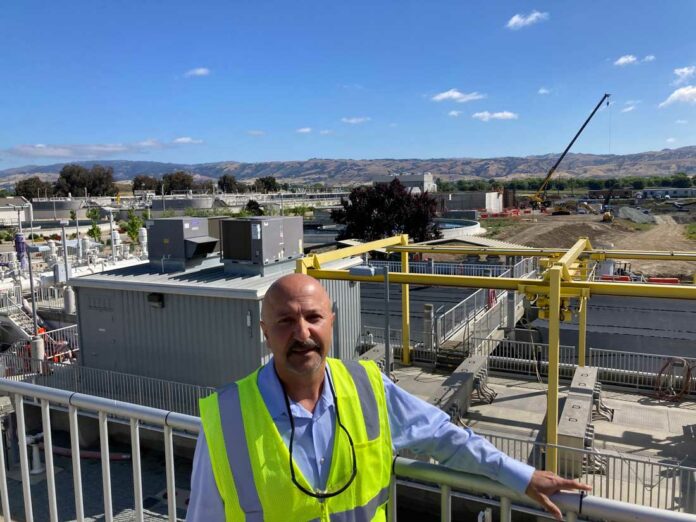
An expansion project underway at the South County Regional Wastewater plant will increase the treatment facility’s capacity by nearly 30%, bring advanced technology to the local recycled water production system, tighten South Valley’s commitment to sustainability and help accommodate the long-term growth coming to Gilroy and Morgan Hill, according to authorities.
Construction on the sewage treatment plant expansion in Gilroy started in May 2021, and is about one-third complete, according to South County Regional Wastewater Authority (SCRWA) Programs Manager Saeid Vaziry. It is projected to be complete in 2024, then it will take another year to evaluate and commission it for official use.
The plant expansion will increase the SCRWA facility’s daily wastewater treatment capacity from 8.5 million to 11 million gallons per day, Vaziry explained.
The new facility is designed with a 13,000-square-foot treatment area (about three Olympic size swimming pools) and will use “cutting-edge membrane technology” to remove nutrients from wastewater, says a statement from Stantec, the engineering firm contracted by SCRWA to build the expansion. The project also includes new screening facilities, bioreactors, membrane basins, blowers, a chemical feed and storage facility, as well as a facility to handle solid wastes.
What that means, Vaziry explained on a recent tour of the SCRWA plant, is the expansion will be more efficient than existing filtration and treatment facilities on site, and result in a higher-quality recycled water byproduct.
“It’s the best available technology. Every (new) sewer treatment plant is using this technology,” Vaziry said.
He added in an email: “The (membrane biological reactor) treatment system reduces the overall footprint of the unit processes compared to…the existing system of oxidation ditches, clarifiers and filters…The submerged membranes act as compact filters with thousands of hollow strands or tubes with microscopic holes, smaller than the diameter of a human hair, allowing for removal of only clean water.”
The plant addition will prolong the growth capacity of the facility that serves Morgan Hill and Gilroy for more than a decade, Stantec added.
“Adding a membrane bioreactor to SCRWA’s wastewater plant offers more reliability and redundancy to the facility, while also improving sustainability,” said Billy Wong, Stantec project manager. “We are excited to support SCRWA as it continues to improve this critical infrastructure and prepare for the next 15 years of growth.”
The total project cost is about $82 million, counting “soft costs” and a 15% contingency, Vaziry said. It is funded primarily by bonds issued by the SCRWA board of directors.
The production of recycled water is an increasingly pivotal use for the SCRWA facility and the goal of long-term sustainability, considering the uncertainty of statewide water supplies during a drought that is poised to only get worse. Recycled water does not rely on temperamental climate and geologic conditions, and can be used for irrigation and industrial purposes—offsetting the use of valuable drinking water supplies.
In 2021, the SCRWA plant was able to convert about 38% of the total wastewater it received into recycled water, Vaziry said. That’s about 850 million gallons of recycled water.
Customers and properties that use this recycled water for non-potable purposes—distributed by purple pipes owned by the Valley Water district—include San Felipe Farms, the Calpine energy plant in Gilroy, B&T Farms, McCarthy Business Park, United Natural Foods and Eagle Ridge Golf Course. The City of Gilroy uses recycled water for irrigation at numerous public properties, including Christmas Hill Park.
Most of the SCRWA plant’s recycled water is used in Gilroy simply due to its location on Southside Drive in the southern part of town. Costs to distribute the product increase as new pipes are planned and installed farther from the source, according to Vaziry.
In the overall picture in Santa Clara County, recycled water is still a small portion of total use, according to Valley Water staff. Countywide last year, recycled water accounted for 5% of total supplies, or about 17,000 acre-feet.
But the increased use of recycled water is key to Valley Water’s long-term supply strategy. The district has a goal to increase recycled water use to 10% of total supplies and develop 24,000 acre feet of “potable reuse” drinking water by 2040, Valley Water spokesperson Matt Keller said in an email.
Other recycled water facilities in Santa Clara County include the Silicon Valley Advanced Water Purification Center in San Jose and the Wolf Road recycled water pipeline in Sunnyvale.
Valley Water works with all wastewater treatment plants in the county and has been a longtime supporter of creating more recycled water.
“Santa Clara County is in a drought emergency and the time is now to say yes to saving water to protect our water supplies,” Valley Water Director John Varela, who represents South County on the board, said in a statement. “Valley Water continues to invest in infrastructure to increase our use of recycled and purified water to help meet the needs of residents, businesses and farms in Santa Clara County.”
The SCRWA plant serves as a municipal wastewater treatment facility for residential, commercial and industrial customers in both Morgan Hill and Gilroy. It is operated by a joint powers authority and a board of directors that consists of three Gilroy city council members and two Morgan Hill council members. The plant’s general manager is Gilroy City Administrator Jimmy Forbis.
Costs to run the SCRWA plant are split 60/40 by the cities of Gilroy and Morgan Hill, respectively.














